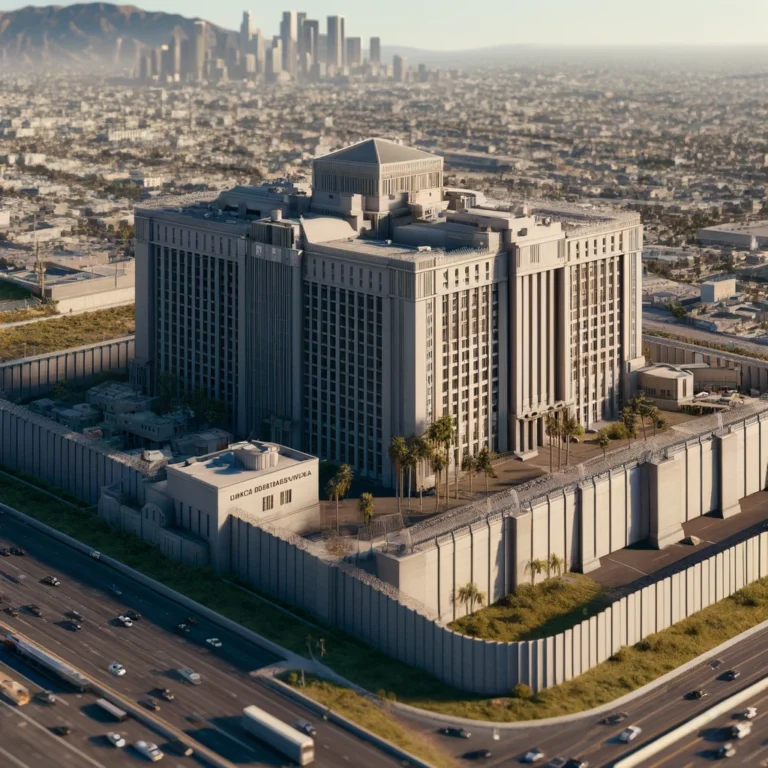LA County | Los Angeles Men’s Central Jail – Info & Updates
Table of Contents
- An Overview of the Los Angeles County Jail System
- The History and Structure of Men’s Central Jail
- Informative List
- The Push for Closure and Alternatives to Incarceration
- The Impact of the Jail Closure on the Community
- Frequently Asked Questions (FAQs)
- Insights

An Overview of the Los Angeles County Jail System
Los Angeles County is home to the most extensive jail system in the United States, with Men’s Central Jail (MCJ) playing a significant role. Located at 441 Bauchet Street in downtown Los Angeles, this sprawling complex has been a critical component of the Los Angeles County Sheriff’s Department (LASD) since it opened in 1963. Over the years, the jail system has faced a multitude of challenges, including overcrowding, inhumane conditions, and a high rate of inmate deaths in custody.
The History and Structure of Men’s Central Jail
Men’s Central Jail, also known as MCJ, was initially designed to house approximately 5,000 inmates. It is part of a larger complex that includes the Twin Towers Correctional Facility and the Inmate Reception Center. However, the jail has often exceeded its intended capacity, leading to severe overcrowding and unsanitary conditions. This has sparked public outcry and led to calls for reform.
In recent years, the Los Angeles County Board of Supervisors has been under pressure to address the issues plaguing the jail system. The jail’s physical structure, built in 1963, has deteriorated over time, contributing to safety and health concerns for both inmates and staff. The lack of adequate mental health facilities and substance abuse treatment programs further exacerbates these problems.
Informative List
Here is a list of key points to understand about the Los Angeles Men’s Central Jail, including significant details, notable dates, and relevant stakeholders:
- Los Angeles County Sheriff: The leading authority overseeing the jail system in LA County.
- 90012: The postal code for the central jail in Los Angeles is a notable reference for anyone seeking to visit or contact the facility.
- Closure of the Jail: An ongoing process to close Men’s Central Jail by 2024, with the LA County Board of Supervisors leading the charge.
- Largest Jail: Men’s Central Jail, part of the most extensive jail system in the U.S., is at the heart of significant discussions regarding reform and closure.
- Detention: Refers to the housing of inmates within the jail, including those awaiting trial or serving sentences.
- Daily News: Outlets like the Los Angeles Times and other daily news publications are closely following the jail’s closure and its broader implications.
- Prison and Jail Within: Points to the overall structure and layout, indicating that Men’s Central Jail is a vital part of a larger prison complex.
- Los Angeles Sheriff’s Department: Also known as LASD, this department manages the jail system and is involved in the closure plan.
- Plan to Close: The LA County Board of Supervisors has developed a plan to close Men’s Central Jail by 2024, involving the transfer or release of inmates and the reallocation of resources.
- Lasd.org: The official LASD website, a valuable resource for information about visiting hours, policies, and updates on the jail’s status.
- Cashier, Privacy Policy, and External Links: Important aspects for those interacting with the jail system, offering guidelines on payments, privacy rules, and additional resources.
- ADA Accessibility: Indicates compliance with the Americans with Disabilities Act, ensuring that the jail system is accessible to all.
- Helen Jones and Died in Custody: Helen Jones is a crucial figure advocating for inmate rights, especially after experiencing the loss of her son in jail custody.
- Awaiting Trial and Pretrial: Refers to inmates held at Men’s Central Jail while they await court appearances or trial dates.
- Mental Health Beds: Indicates a shortage of appropriate mental health facilities within the jail system, highlighting the need for reform.
The Push for Closure and Alternatives to Incarceration
In 2021, the Los Angeles County Board of Supervisors voted to close Men’s Central Jail, following extensive criticism of its conditions and demands for more humane alternatives to incarceration. The vote came after years of advocacy from community groups, legal experts, and civil rights organizations who highlighted the jail’s deplorable conditions and the toll it takes on inmates’ dignity and power.
Supervisor Hilda Solis co-authored the motion to close Men’s Central Jail, citing the need for a five-year plan to replace the aging facility with a new one that prioritizes mental health services and other support systems for incarcerated individuals. The closure plan, however, presents a significant challenge for the LASD, which must find alternatives to house the jail’s large population.
The Impact of the Jail Closure on the Community
The closure of Men’s Central Jail has far-reaching implications for the Los Angeles County jail system and the community it serves. While the move is intended to improve conditions and address human rights concerns, it also raises questions about where inmates will be housed and how the LASD will manage the transition.
In response to these challenges, the Los Angeles County Board of Supervisors has proposed various alternatives to incarceration, such as expanded mental health services, community-based rehabilitation programs, and diversion initiatives. These alternatives aim to reduce the jail population while providing support to those who need it most. However, implementing these programs on a large scale will require significant funding and coordination among multiple agencies.

Los Angeles Men’s Central Jail Frequently Asked Questions (FAQs)
Q: What is the current status of the Los Angeles Men’s Central Jail?
A: The Los Angeles County Board of Supervisors has voted to close Men’s Central Jail by 2024, with a five-year plan in place to ensure a smooth transition and relocation of inmates.
Q: Who is responsible for managing the jail system in Los Angeles County?
A: The Los Angeles County Sheriff’s Department (LASD) oversees the jail system, including Men’s Central Jail. The LASD is working closely with the LA County Board of Supervisors to ensure the safe closure of the jail.
Q: What are the visiting hours for Men’s Central Jail?
A: Visiting hours may vary, but the LASD website (lasd.org) provides detailed information on visiting schedules, rules, and requirements. It’s best to check the site for the latest updates.
Q: What are the main reasons for closing Men’s Central Jail?
A: Men’s Central Jail has faced significant issues, including overcrowding, inhumane conditions, and inadequate mental health facilities. The closure aims to address these problems and move toward a more humane approach to incarceration.
Q: What alternatives to incarceration are being considered as part of the jail’s closure?
A: The LA County Board of Supervisors is exploring various alternatives, such as community-based rehabilitation programs, mental health services, and diversion initiatives, to reduce the jail population and offer support to those in need.
Public Concerns and Calls for Transparency
The decision to close Men’s Central Jail has generated mixed reactions from the public. While many applaud the move toward more humane treatment of inmates, others are concerned about the potential impact on public safety and the cost of building a replacement facility. LASD has acknowledged these concerns and is committed to keeping the public informed through official statements and updates on its website (lasd.org).
Transparency is a critical component of the closure plan, with the LASD providing detailed information on visiting hours, custody procedures, and inmate rights. The Los Angeles Times and other local news outlets have also covered the jail’s closure extensively, shedding light on the complex issues surrounding the jail system and its future.
The Road Ahead: A New Era for the LA County Jail System
The closure of Men’s Central Jail marks a turning point for the Los Angeles County jail system. While the process will take time, it represents a significant step toward addressing the systemic issues that have plagued the county’s jail facilities for decades. The transition will require careful planning, collaboration among stakeholders, and a commitment to finding alternatives to incarceration that promote rehabilitation and reduce recidivism.
As the Los Angeles County Board of Supervisors moves forward with its plan, it is essential to maintain a focus on the rights and dignity of incarcerated individuals. The ultimate goal is to create a jail system that prioritizes human rights, offers meaningful rehabilitation opportunities, and promotes a safer and more just society for all.
Insights
- Closure of Men’s Central Jail: The decision to close the largest jail in the U.S. by 2024 is a significant development in the LA County jail system.
- Alternatives to Incarceration: The closure plan includes exploring various options, aiming for a more humane and rehabilitative approach to the justice system.
- Transparency and Communication: The LASD and the LA County Board of Supervisors are providing detailed information to keep the public informed about the jail’s status, including visiting hours, policies, and other vital updates.
- Challenges and Opportunities: While the closure presents challenges, such as overcrowding and inmate relocation, it also offers opportunities to address systemic issues and create a more just and equitable system.
- Public Safety and Accountability: Ensuring public safety and accountability remains a priority, with a focus on balancing community needs and the rights of incarcerated individuals.
